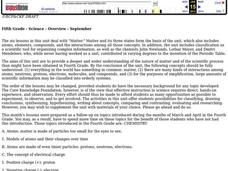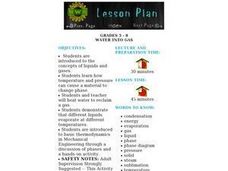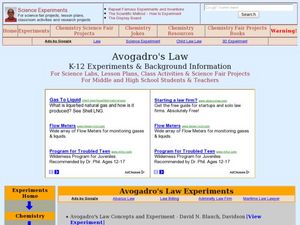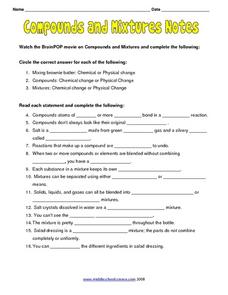Curated OER
Matter
Fifth graders investigate the nature of matter and of the scientific processes associated with them in this series of lessons.
Curated OER
Water Into Gas
Students investigate how temperature and pressure cause a material to change phase. They heat water to reclaim a gas. They demonstrate that different liquids evaporate at different temperatures.
Curated OER
Matter: Three States of Matter
Learners discover characteristics of each of the three states of matter: solid, liquid and gas.
Curated OER
Weather Art in Space Settlements
Learners demonstrate a cloud formation and the relation between pressure and temperature in gases. They explain how clouds could be created in space settlements and see the relation between pressure and temperature in gases.
Curated OER
Blast Off to Learning
Pupils explain the laws of volume and pressure, identify what a limiting reagent is and why it is important in a chemical reaction, and distinguish between fossil fuels and renewable energy sources.
Curated OER
Avogadro's Law
Students study Avogadro's law and what it means in science. In this gaseous lesson students complete an Avogadro's law experiment.
Curated OER
Phases of Matter
Students describe the motion of solids, liquids and gases. In this chemistry lesson, students describe how temperature affect motion of the particles. They determine the physical properties of each phase.
Curated OER
The Interactive Periodic Table of the Elements
Students study the different types of metals. For this investigative lesson students watch a demonstration on the effects of temperature on atoms and take a tour through baone matter.
Curated OER
What's the Matter?
Students investigate matter. In this matter instructional activity, students identify types of matter and characteristics of each type. Students discuss matter and create matter posters to show understanding.
Curated OER
Meter Reading Using Place Value
Fourth graders read gas meters to measure cubic feet and learn place values. For this place value lesson, 4th graders watch a video about meter reading and discuss place value on the gas meter dials. Students study a related chart and...
Curated OER
Gases
In this gases worksheet, students review the 3 states of matter, the types of molecular motion, and the characteristics of gases. This worksheet has 30 problems to solve.
Curated OER
Compounds and Mixtures Notes
In this matter worksheet, students watch a movie and then compare the differences between compounds and mixtures. This worksheet has 16 fill in the blank questions.
Curated OER
Sea of Air #3
For this air worksheet, learners determine the major gases found in the earth's atmosphere and review STP and Avogadro's Law. This worksheet has 1 true or false, 2 fill in the blank, and 7 short answer questions.
Curated OER
Chemistry Review
In this chemistry overview worksheet, students review stoichiometry, states of matter, thermochemistry, gas laws, chemical bonding, molarity, chemical equilibria, and kinetics. This worksheet has 41 problems to solve.
Curated OER
What Are Physical Changes in Matter?
In this matter worksheet, students write down 3 causes and effects of physical changes in matter. This worksheet is a graphic organizer.
Curated OER
What is a Physical Change in Matter?
In this matter worksheet, students complete a graphic organizer by writing in 1 thing that causes a physical change in matter and 3 effects this has on matter.
Curated OER
States of Matter
In this states of matter worksheet, students will complete the graphic organizer by writing in the 3 states of matter: solid, liquid, and gas.
Curated OER
What Are Three States of Matter?
In this states of matter worksheet, students will write down a main idea relating to the three states of matter. Then students will write in five supporting details in this graphic organizer.
Curated OER
Boyle's Law
In this Boyle's Law instructional activity, students respond to several short answer questions that pertain to Boyle's Law. They determine the volume of gas when pressure is increased and/or decreased. Students also determine what the...
Curated OER
Charles' Law
In this Charles' Law worksheet, students respond to several short answer questions as they pertain to Charles' Law. they calculate the decrease in temperature when it is compressed a specific amount. Students also determine the volume...
Curated OER
Gas Law Problems
In this gas law problems worksheet, students research and answer nineteen unique questions associated with gas laws. Students work in pairs to answer the twenty questions asked.
Curated OER
Concept Questions on Gases
In this science worksheet, students examine the concepts related to gases and use the information in order to create an understanding to answer the given questions.
Curated OER
Gases, Liquids And Solids
Young scholars investigate how gases are different from solids and liquids and that they can evaporate and condense. They observe water boiling in a teapot and discuss what happens when the steam touches a cold window, complete an...
Curated OER
Floating Candles
High schoolers observe a combustion reaction and deduce the components necessary for the reaction to occur. They also identify and interpret the relationship between pressure, volume, and number of molecules for gasses. Finally, students...

























